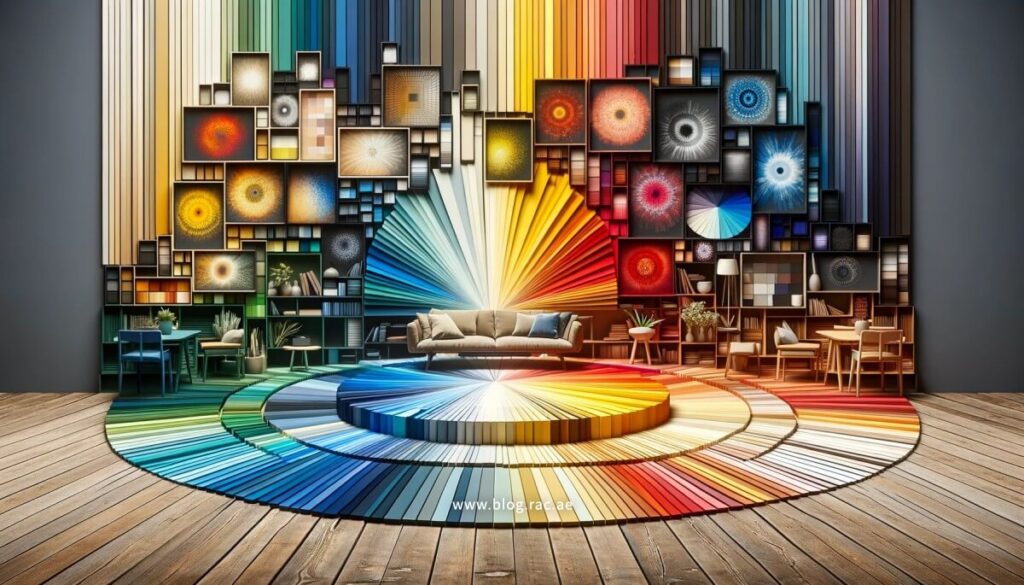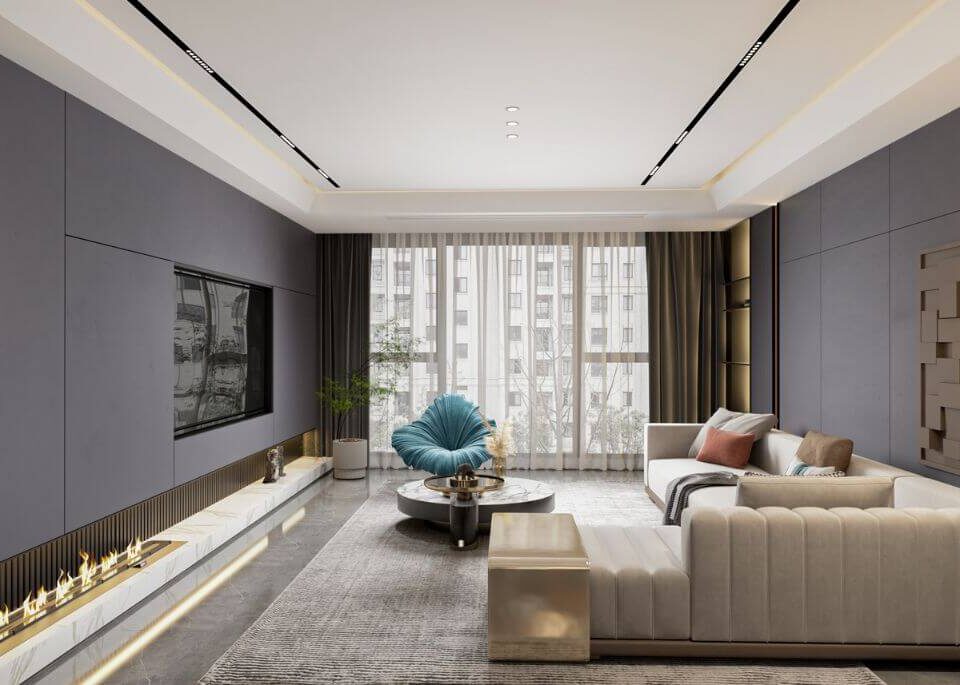
Crafting Elegance on a Budget
March 6, 2024
Renovation on a Deadline: Tips for Staying on Track and on Budget
March 8, 2024Transform Your Home: Mastering Paint Colors for Every Room

Selecting the ideal paint hue for each area of your house is an important yet challenging task that significantly contributes to the atmosphere and functionality of your living environment. Paint color’s impact goes beyond simple visual appeal; it affects our emotions, perception, and even a room’s practicality. Given the vast array of available colors and shades, finding the perfect match can seem like a formidable task. This guide is designed to simplify the color selection process by taking into account factors such as the room’s function, lighting, dimensions, and the psychological effects of colors, enabling you to make choices that resonate with your personal style and fulfill your requirements.
Table of Contents
Understanding Color Psychology
The study of how color influences human behavior, known as color psychology, is essential in the realm of interior decorating. Colors can provoke a wide range of emotions and behaviors. For example, shades of blue are often linked to tranquility and relaxation, ideal for spaces like bedrooms and baths where a peaceful environment is desired. On the other hand, red hues are invigorating and can boost energy, making them a great choice for spaces like dining rooms and kitchens that benefit from a lively atmosphere. Grasping the emotional impacts of colors is a critical step in selecting a palette that is not only visually appealing but also contributes to the occupants’ emotional well-being.

Assessing Your Space
A. Lighting Considerations
The perception of paint color is greatly influenced by the lighting within a space. True colors are best displayed in natural light, whereas artificial light can shift how colors appear. Rooms facing north tend to have cooler, more bluish light, which can make warm colors look less vibrant. Conversely, rooms with southern exposure enjoy warm, bright light that tends to make colors appear more vivid. Taking into account the lighting conditions in your room is crucial when choosing colors that will complement the space.
B. Room Size and Layout
Paint color can also affect how the size and layout of a room are perceived. Light hues are known to open up a space, making it feel larger and more airy, which is perfect for smaller areas. Dark shades can lend depth and coziness to larger spaces but might make smaller rooms seem tighter. The layout of your space, including features like ceiling height and window dimensions, should also play a role in your color selection to accentuate the room’s best attributes.
C. Architectural Elements and Furniture
It’s important to take into account the room’s existing architectural features and furnishings when choosing paint colors. If your space boasts striking crown molding or rich hardwood floors, select hues that accentuate these elements. Likewise, if your furniture follows a specific color theme, your wall color should complement and enhance these tones without dominating them.
Color Schemes and Themes
A. Understanding Color Schemes
Deciding on a color scheme is a fundamental part of creating a unified appearance in your room or throughout your home. Whether you’re inclined towards a monochromatic palette, which incorporates different tints and shades of a single color, or a complementary scheme that combines colors opposite each other on the color wheel for a dynamic contrast, grasping color scheme basics is key to your decision-making process. The scheme you choose should suit both the purpose of the room and your personal aesthetic, crafting an environment that is both harmonious and visually appealing.
B. Theme-Based Colors
For those aiming to establish a particular theme or ambiance in a room, selecting theme-appropriate colors is critical. For a beachy vibe, consider soft blues, greens, and neutrals that mimic the shore. A minimalist approach might favor a palette of whites, grays, and blacks, emphasizing simplicity and clean lines. Opting for theme-based colors ensures the room’s decor is cohesive and engaging.
Room-by-Room Guide
A. Living Room
As the central gathering spot in the home, the living room should foster a sense of welcome and comfort. Opt for warm neutrals like tan, soft gray, and earthy hues to create a snug setting, or employ gentle blues and greens for a serene effect. Taking into account the natural lighting and your interior decor will ensure the color choice complements the space’s purpose and style.
B. Kitchen
The kitchen, often a home’s bustling center, demands colors that can handle high activity while stimulating appetite and conversation. Vibrant warmer colors such as reds, yellows, and oranges can invigorate the space and encourage dining, whereas cooler tones like blues and greens promote a clean, calm environment for cooking. Opt for durable, easy-to-clean paint finishes in areas that are likely to get messy.
C. Bedroom
Bedrooms, our personal sanctuaries, require hues that promote relaxation and rest. Cool shades like gentle blues, lavenders, and greens are renowned for their soothing properties, making them perfect for bedroom walls. For those who favor a warmer palette, soft tones such as muted rose or clay provide coziness without overwhelming the senses.
D. Bathroom
In bathrooms, opt for moisture-resistant paints in colors that create a clean, revitalizing space. Light shades such as pale blues, greens, and neutrals can make small bathrooms appear larger and more inviting. For a spa-like feel, consider luxurious, serene colors like soft gray or delicate aqua.
E. Home Office
The right color selection is key to fostering a productive and encouraging home office atmosphere. Greens and blues can aid in concentration and stress reduction, while soft yellows and earthy hues may enhance creativity and energy. Balance your professional needs with your personal taste to craft a space that’s both inspiring and functional.
F. Children’s Rooms
Children’s bedrooms are a canvas for creativity and color. Vivid, joyful colors like yellow, green, or blue can promote learning and creativity, whereas softer tones offer a calming environment for rest. Choose washable paints for easy upkeep and pick versatile colors that can evolve with your child’s age and preferences.
Trends and Innovations in Paint Colors
Keeping up with current color trends can provide inspiration and introduce new, innovative ideas for your home. From bold, deep colors making a statement to gentle, nature-inspired tones fostering peace, trends can influence your color choices. Moreover, advancements in paint technology offer benefits such as enhanced durability, environmentally friendly options, and even paints that improve indoor air quality, broadening your selections and considerations.

Practical Tips for Choosing Paint Colors
A. Sampling Paint Colors
Testing paint colors in your intended space before committing is essential. Apply samples to small wall sections or use sizable boards you can move around to see how the color shifts under different lighting throughout the day. This approach helps avoid expensive mistakes and ensures you’re happy with your final choice.
B. Consulting Professionals
If choosing becomes overwhelming, seek the expertise of an interior designer or color consultant. These professionals can offer personalized recommendations based on your space, preferences, and style, streamlining the selection process and ensuring a result that meets your vision.
C. Online Tools and Resources
Numerous paint brands and interior design platforms provide virtual tools that let you experiment with different colors in your rooms. These digital resources are invaluable for visualizing potential outcomes and exploring color schemes without any physical commitment.
Key Takeaways: Mastering Paint Colors for Every Room
Selecting the perfect paint color for each room involves understanding color psychology, assessing your space’s lighting, size, and layout, and considering existing architectural elements and furniture. Utilizing color schemes and theme-based colors can create a harmonious and visually appealing environment. Room-specific color guides help ensure functionality and emotional well-being, while staying updated with trends and using innovative paint options enhance the overall aesthetic. By following these guidelines, you can transform your home into a personalized and elegant space that reflects your unique style.
Conclusion
Selecting the appropriate paint color for each area in your home involves a mix of artistic intuition and scientific understanding, considering the psychological impacts, lighting, dimensions, and existing decor. By familiarizing yourself with color theory basics, evaluating your space, and aligning your choices with the room’s purpose and your personal style, you can choose hues that enhance your home’s aesthetics and functionality. Remember, while paint is transformative, it’s also reversible, so feel free to experiment and express your uniqueness. With proper planning and an open mind, you can create spaces that truly reflect your distinct taste and transform your house into a home.
FAQs
1. Why is selecting the right paint color for each room important?
Choosing the right paint color significantly impacts the atmosphere, functionality, and overall aesthetics of your living environment, affecting emotions, perceptions, and practical use.
2. What is color psychology and how does it influence interior design?
Color psychology studies how colors affect human behavior and emotions. For instance, blue promotes tranquility and is ideal for bedrooms, while red energizes and suits spaces like dining rooms and kitchens.
3. How does lighting affect paint color perception?
Natural light shows true colors, while artificial light can alter their appearance. North-facing rooms may make warm colors appear dull, whereas southern exposure enhances color vibrancy.
4. What should I consider about room size and layout when choosing paint colors?
Light hues make small spaces feel larger and airy, while dark shades add depth and coziness to larger rooms. Consider ceiling height and window dimensions to highlight the room’s best features.
5. How do existing architectural elements and furniture influence paint color choices?
Select colors that accentuate architectural features like crown molding and complement existing furniture, ensuring a cohesive and harmonious look.
6. What are color schemes and how do they affect room design?
Color schemes create a unified appearance. Monochromatic schemes use variations of a single color, while complementary schemes combine opposite colors for dynamic contrast, suiting both room purpose and personal aesthetic.
7. How can theme-based colors enhance a room’s decor?
Theme-based colors ensure cohesive and engaging decor. For instance, soft blues and greens create a beachy vibe, while whites, grays, and blacks suit a minimalist theme.
8. What paint colors are suitable for living rooms?
Living rooms benefit from warm neutrals like tan and soft gray for a cozy feel, or gentle blues and greens for serenity, taking into account natural lighting and decor style.
9. Which colors work best in kitchens?
Vibrant warmer colors like reds, yellows, and oranges stimulate appetite and conversation, while cooler tones like blues and greens create a clean, calm cooking environment.
10. What paint colors promote relaxation in bedrooms?
Cool shades like gentle blues, lavenders, and greens are known for their soothing properties, while soft tones such as muted rose or clay provide coziness without overwhelming the senses.
11. How can paint colors enhance bathroom spaces?
Moisture-resistant paints in light shades like pale blues, greens, and neutrals make small bathrooms appear larger and inviting, while soft gray or delicate aqua create a spa-like feel.
12. What are the best paint colors for a home office?
Greens and blues aid concentration and stress reduction, while soft yellows and earthy hues enhance creativity and energy, balancing professional needs with personal taste.
13. What colors are ideal for children’s rooms?
Vivid colors like yellow, green, or blue promote learning and creativity, while softer tones offer a calming environment for rest. Choose washable paints for easy upkeep and versatility.
14. How can current color trends inspire my paint choices?
Trends offer new ideas, from bold, deep colors to gentle, nature-inspired tones. Paint technology advancements provide benefits like enhanced durability and eco-friendliness.
15. What are practical tips for choosing paint colors?
Sampling colors in your space before committing helps avoid mistakes. Consulting professionals and using online tools can provide personalized recommendations and visualize outcomes.

